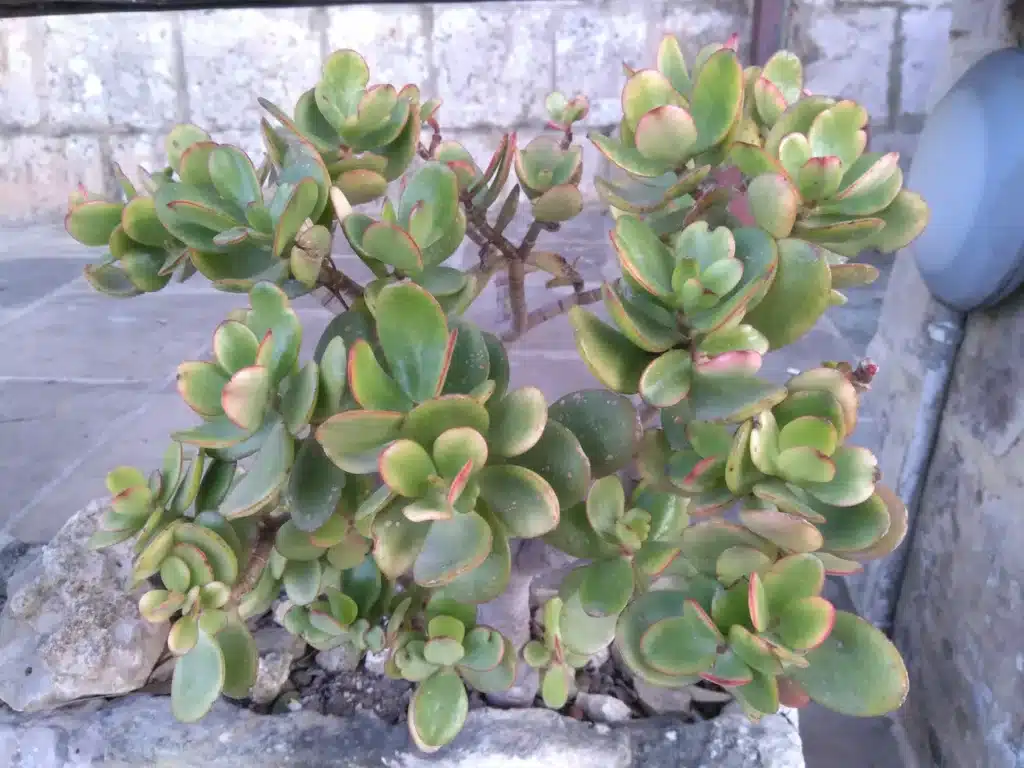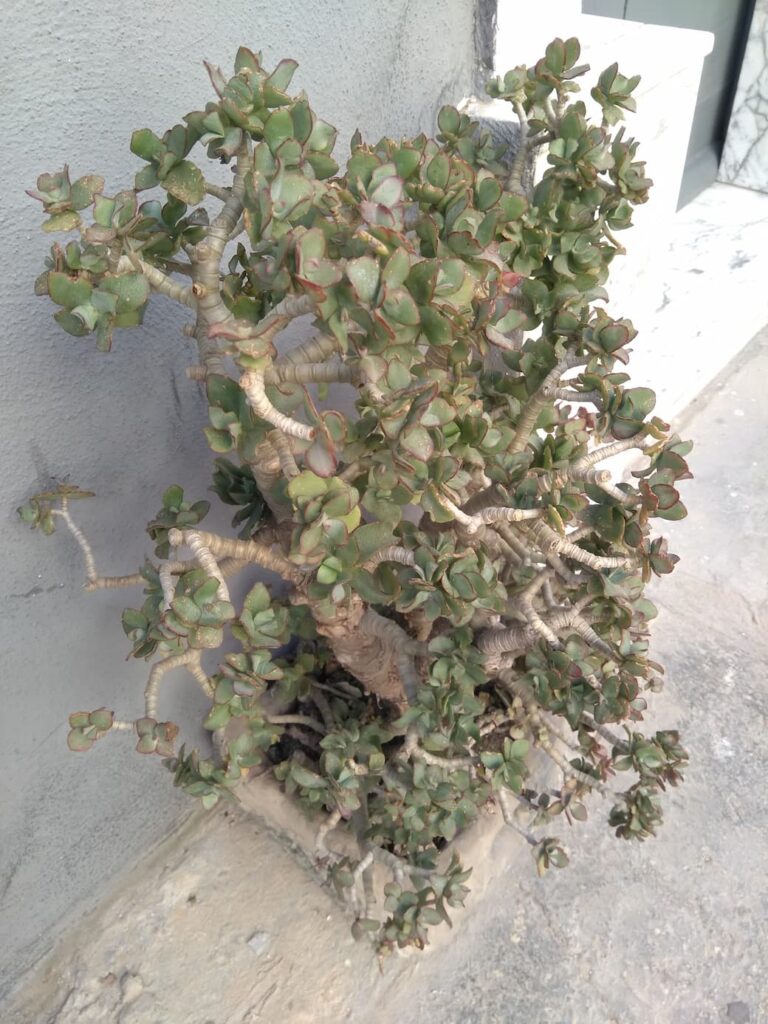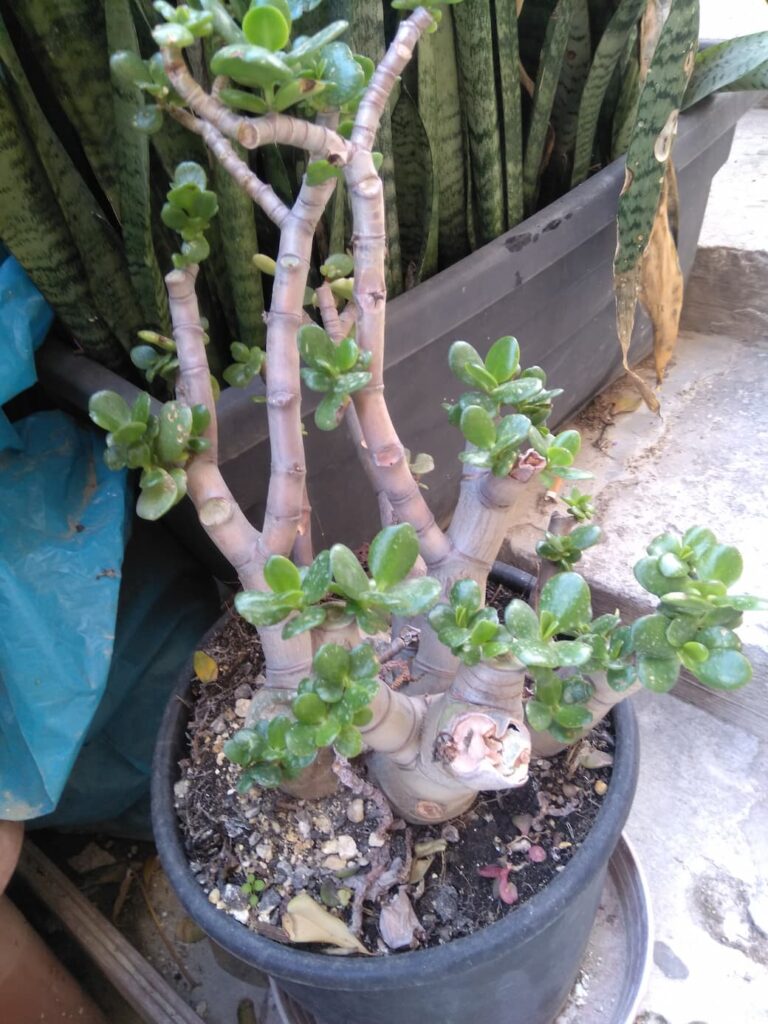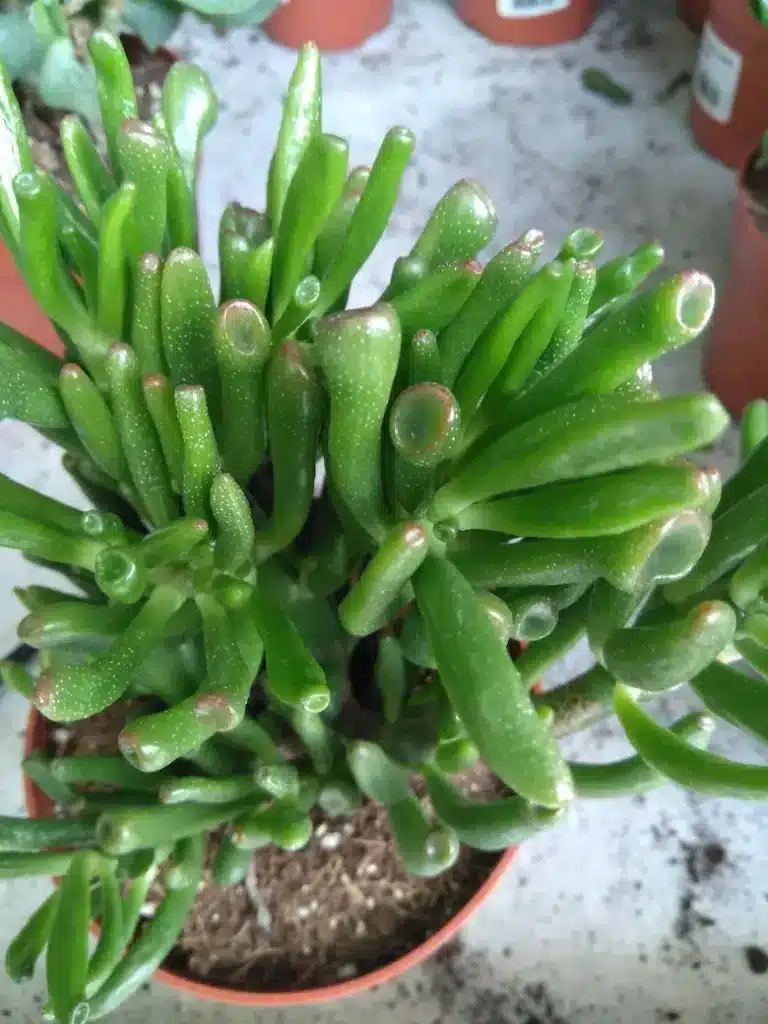Jade plant Care – Grow Crassula ovata

Key takeaways - Jade plant / Crassula Ovata
-
Common Plant Name
- Jade Plant or Money Plant
-
Botanical Name
- Crassula Ovata
-
Botanical Family
- Crassulaceae
-
Plant Type
- Succulent
-
Mature Size
- Up to 3 feet in height
-
Sun Exposure
- Bright, indirect sunlight
-
Soil Type
- Well-draining, cactus or succulent mix
-
Soil pH Neutral
- Slightly acidic to slightly alkaline
-
Bloom Time
- Late winter to early spring
-
Flower Color
- Pink or white, star-shaped flowers
-
Hardiness Zones
- 10 to 11
-
Native Region
- South Africa
Jade plants, a member of the Crassulaceae family, are very popular succulent houseplants. It is a natural bonsai with thick, woody trunks and succulent leaves. This plant’s reputation has been formed over time and developed a fascinating cultural presence in the plant world. There are many traditions, stories and anecdotes which have given the Jade plant plenty of nicknames such as: Silver Dollar Plant, Money Tree, Fortune Plant, Good Luck Plant, Beestebul, Silver Jade Plant, Money Plant, Chinese Jade, Shrek ears (Crassula ovata ‘Gollum’) etc.
Jade plants are native to South Africa’s dry and arid regions with seasonal drought and rainfall. A fully grown plant can grow to around 3 to 6 feet tall (90 cm – 180 cm) with proper care, but be patient, since they grow about 3 inches per every year.
How To Guide - Jade Plants
Jade Plants are often seen in public spaces such as shop windows, office buildings or city centre outdoor landscaping. They are very common as permanent outdoor plants in warmer climates where the temperature is permanently well above the freezing point. Since they typically grow indoors, they can be purchased or propagated at any time.
Jade plant care is generally a very easy mission without any unexpected drama, grown indoors or outdoors. With proper care, Jade plants are easily propagated, so you can spread their presence around your home and share them with friends.
Watering Jade plants
The best way to water Jade plants is pretty straightforward, as for succulent plants in general. Feed them plenty of water during the growing season, roughly once a week, and let them dry out between waterings. Less frequent watering is required during the winter months, roughly once per month is enough. As succulents in general, be careful not to overwater Jade plants since it may cause a variety of diseases. Overwatering is fatal to all succulents, so it’s advised to keep the medium too dry rather than too wet, since a prolonged drought never is an issue for these plants.
Jade plants are very drought tolerant. However, a generous watering regime is essential, particularly during the spring and summer when the growing season occurs. Proper drainage is crucial for Jade plants since they never should sit for longer periods in water.
Best light for Jade plants
Proper light is a crucial factor for the well-being of Jade plants. They require plenty of sun, but too much harsh direct sunshine can burn the leaves, particularly those of seedlings and young plants. If you live in colder hardiness zones, they usually tolerate direct sunlight much better. However, insufficient light can cause weak, leggy growth, potentially leading to the plant’s collapse. This is another reason to water Jade plants sparingly during the dark winter months.
Placing Jade plants in a south- or west-facing window ensures sufficient light indoors. Preferably at least five to six hours of bright, or indirect sunlight per day is perfect. The most appropriate light depends on where you live. However, if you are located far up north, you may need a grow light as support through the long and dark winter months

Best Soil
The best soil for your jade plant is pretty much any well-draining succulent soil mix. Preferably a well-draining soil, with neutral to slightly acidic PH level, to prevent excess moisture from accumulating, which may lead to fungi and other diseases. If you use a regular potting mix, add some perlite to enhance drainage.
Best Temperature
The best temperature for Jade plants is roughly average household temperatures ranging from 60°F to 80°F (28-25°C). They can handle cooler temperatures at night and during the winter, but temperatures below 50°F (10°C) should be avoided.
Fertilize Jade plants
Fertilizing your jade plant with a controlled-release fertilizer at the beginning of the season or weekly with a weak liquid solution is recommended. A balanced 10-10-10 fertilizer on mature plants and a fertilizer with less nitrogen on young plants can help with their growth. Avoid a normal gardening fertilizer which typically has too high levels of Nitrogen to keep a Jade plant happy.
How to propagate Jade plants
Jade plants are easy to propagate and new plants can be propagated from a single leaf or cutting from a parent plant.
Propagate Jade at the beginning of the growing season in spring and during summer. Since the plant develops a positive momentum with increased sunlight and temperature.
Propagate a new Jade plant from leaf
- When propagating a Jade leaf, let initially it dry out for a few days for the damaged part to heal.
- Place the Jade leaves in good light on top of slightly moist soil, or in a jar with soil and controlled humidity.
- The leaf will shortly start to establish roots without much need for assistance.
- Rather quickly, you will see tiny growths starting to appear from the leaf. If given time, this is the beginning of a new Jade tree.
- The new plant will have the same DNA as the parent plant. If you want a completely unique plant, you need to grow it from seed. The leaves may seem very small and fragile, but they have a great appetite for life.
Propagate a new Jade plant from cutting
- When propagating a Jade plant cutting, take a healthy, mature cutting that is at least 2 to 3 inches (5cm-10cm) long and allow it to sit in a warm, dry place for several days.
- Plant the cutting in a well-draining succulent mix with gravel, vermiculite or perlite, and new roots should start to develop in a few weeks.
- You can dip the wound of the cutting in a rooting hormone powder. Although, using a rooting hormone is not necessary, but will improve your odds a bit.
- Modest watering just to keep the soil damp. After a few weeks, the cutting should develop roots, and you can begin caring for it like a mature jade plant.

How to grow Jade plants from seed
It is so easy to grow a new Jade plant from a cutting or a leaf, so growing from seed is almost redundant, but can be done:
Begin with well-draining soil, such as a mix of starter soil and perlite for optimal aeration.- Gently press the seeds into the soil, ensuring they are not buried too deep.
- Keep the soil consistently moist.
- Place the pot in indirect sunlight. As the tiny green shoots emerge, resist the temptation to overwater.
- Gradually introduce your Crassula Ovata to more sunlight
Jade plants and Feng Shui
Jade plants are very popular among Feng Shui-practitioners, who believe the plant has a profound impact on the energy of your home, depending on where it is located.
- Place a Jade plant in the east for family harmony, taking initiatives and good health.
- Place a Jade plant in a west for increased creativity or luck with children.
- Place a Jade plant in a north-western position increase luck of mentoring, teaching and helpfulness.
- Place a Jade plant in the south/east for success in business ventures and monetary luck
Whatever you do, don’t place a Jade plant in the bathroom!
Best pots for Jade plants
For potting and repotting, anything from 4-inch to 8-inch pots with effective drainage holes works well for average-size jade plants, which is in line when choosing the best pots for succulents in general.
Choose a ceramic, terracotta or clay pot if possible, since their material breaths naturally and allows excess moisture to evaporate through the walls, preventing the plant from standing in water. Sometimes smaller Jade plants require repotting every two to three years, while larger specimens require less frequent repotting. If your jade plant seems to be outgrowing its pot or if roots are popping up out of the soil it might be a good idea to repot your plant:
Repotting Jade plants, as well as most other succulents, is rather easy: When the soil is completely dry, try to gently pull up the whole plant and soil in one piece. Or gently loosen the soil from the pot with a knife or other flat tool around the inner walls of the pot to loosen the soil and remove any roots that might be stuck to the sides. Then remove the old soil from the roots, as well as any rotten or dead roots in the process.
Perhaps give the plant the luxury of a new pot with a delicious well-draining succulent soil mix. But, don’t give it water right away. Allow the plant to settle in the new soil for roughly a week or ten days before watering to avoid any initial shock.
Jade Plants and Pests
Jade plants have some sworn enemies from the world of insects that can severely damage the plant if the population is allowed to grow. The most common pest is the mealybug, which builds white soft nests on the plant, often where the leaves attach to the stems. Before using any harmful insecticides and oils, Take a little stick or a toothpick and hunt them down, or just wipe them off the plant, since mealybugs are very fragile. Also, spider mites or scale can cause infestations, which can be treated similarly. Fungus gnats may be a problem for very young plants with a delicate root system, but no match for an older specimen. Besides, letting the soil dry out completely will eliminate any gnat population.
Challenges with Jade plants
Although, jade plants are relatively easy to care for and not very tricky. Although, you may run into some issues that may prevent them from thriving. For instance, shriveled leaves may indicate a lack of water, where the solutions is, believe it or not, to water the plant. If your jade plant is losing leaves frequently, it may indicate an issue with
Pruning
Pruning Jade plants is pretty easy, since as with most succulents, it is a slow grower. It will never overwhelm you with new growth that seemingly came from nowhere. Go ahead and trim Jade plants if needed, preferably ahead of the growing season since they will heal and recover easily with the new growth.
For a taller plant trim the side branches, but never more than half their length. For a wider plant, cut the trunk and allow the branches to spread. Also, it is advised to cut looping branches of old specimens to maintain a healthy plant.
How to Get Crassula Ovata to Bloom
As a Jade plant matures, it develops a natural inclination to produce clusters of star-shaped flowers. Provide direct or indirect sunlight, at least six hours a day, to stimulate blooming.
Maintain a well-balanced fertilizer regimen during the growing season, reducing it in the dormant winter months.
Pruning can also play a role. Trim back leggy growth to encourage a bushier habit, facilitating more bloom production. With the right conditions and a dash of care, your Crassula Ovata will burst into a spectacular display of delicate blossoms.


Gollum Jade (Crassula ovata ‘Gollum or Shrek ears’)
Overwintering Jade plants
When winter knocks on the door, your Crassula Ovata requires a shift in care, especially if you live in a colder climate.
Reduce watering and stop fertilization during the dormant period. Shield it from frost, providing a cozy spot away from chilly drafts. If your region experiences frost, consider bringing your plant indoors to bask in the warmth.
Types of Jade plants
There is a large variet of Jade plants, where they are similar to the original Jade plant but also with distinct features that sets them apart from the mother plant.
Gollum Jade (Crassula Ovata ‘Gollum or Shrek ears’):
- This popular variety is nicknamed “Gollum jade” or “finger jade.” Its leaves have a distinct tubular shape, curving inward with a glossy green hue very much resembling the ears of the beloved cartoon character Shrek.
Hobbit Jade (Crassula Ovata ‘Hobbit’):
- Often referred to as “Hobbit jade” or “leather jade,” this cultivar shares similarities with the Gollum/Shrek ears variety.
- However, it differentiates with its rounder and shorter leaves.
- The leaves boast a flattened appearance, showcasing a rich, dark green pigment.
Variegated Jade (Crassula Ovata ‘Variegata’):
- Enthusiasts commonly refer to this sought-after cultivar as “variegated jade” or “tricolor jade.”
- Its leaves are adorned with cream or yellow edges, accentuated by a prominent green stripe running through the centre.
Blue Bird Jade (Crassula Ovata ‘Blue Bird’):
- This captivating variety is also known as “blue jade” or “silver jade.”
- Its distinctive feature lies in the captivating blue-gray or silvery hue of the leaves.
Sunset Jade (Crassula Ovata ‘Sunset’):
- Renowned for its breathtaking red and yellow foliage, this variety casts a mesmerizing allure.
- The leaves proudly exhibit vivid hues, with fiery red edges gradually transitioning to vibrant yellow toward the centre.
FAQ - Jade plants - Crassula Ovata
Most frequent questions and answers
Jade Plants enjoy direct sunlight or very bright light and should be located in a prime spot with lots of sunlight. As with many succulents, Jade plants get insufficient light, they may develop unnatural growth where they appear leggy and elongated.
With proper care and great conditions, a Jade plant’s lifespan can be around 100 years. It is a plant that can stay in a family for several generations. The older it gets, the more unique it becomes. They grow rather slowly and can easily be trimmed down if needed.
Place a Jade Plant in a south or south-eastern facing window where it gets plenty of sun exposure. Ideally it should receive a few hours of sunlight every day.
An overwatered Jade plant will give you clues such as the leaves starting to get yellow, falling off for no obvious reason. Or the stems may become soft with a droopy appearance and can easily break.
Much like succulents in general, the best way to make a Jade plant happy is to give it lots of light and well-draining soil. Let the soil dry out in between waterings and avoid overwatering where the plant stands in water for days.
Homeowners with pets should be very careful since all parts of the plant are toxic to cats and dogs.
